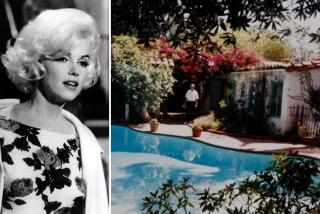Black Millionaire’s Dream Is Revived
- Share via
IRVINGTON, N.Y. — Eighty years ago, America’s first self-made black millionaire built a splendid 34-room mansion to show young blacks what one woman could do and “inspire them to do big things.”
The house, named Villa Lewaro by Enrico Caruso, became a meeting place for black leaders and entertainers. But Madam C.J. Walker lived there barely a year, dying in 1919 in the master bedroom.
When her daughter died, the house had to be sold in 1933 for the Depression-era figure of $47,500. For 50 years it was a retirement home, then was saved from the wrecking ball in the 1980s only because of several nearby 300-year-old trees.
Now it is fulfilling Madam Walker’s dream, thanks to its current owner, Harold Doley, who is turning it into a temporary decorators’ museum to raise money for charity and draw attention to black designers.
The big white house just north of New York City, with a graceful columned portico and Hudson River view, is open to the public as the Madam C.J. Walker Designer Showcase through Nov. 29.
Madam Walker paid $350,000 to build the house in 1918, employing black architect Vertner Tandy “to convince members of my race of the wealth of business possibilities within the race, to point to young Negroes what a lone woman accomplished and to inspire them to do big things.”
Orphaned at 7 and widowed at 20, Madam Walker built a cosmetics empire based on inexpensive hair and scalp treatments for blacks. She shared her wealth with the new National Assn. for the Advancement of Colored People, YMCAs and anti-lynching campaigns.
Doley heard of Madam Walker when he was a child in Louisiana. When he was 21 and working as a trainee on Wall Street, he rode the train up to see her home.
“I fell in love with the house,” he said. “Love at first sight.”
The love was fulfilled in 1993 when Doley, 51, now a wealthy investment banker and the first black with a seat on the New York Stock Exchange, bought the mansion. He won’t reveal the price.
It was clear last week that his love hadn’t cooled. As decorators, designers, painters and plumbers transformed the Italianate Renaissance villa, Doley obviously had a hand in it all--”some would say too much of a hand,” he said.
While being interviewed and giving a tour, he also paid bills, took calls and consulted with Anthony Antine, the designer chairman.
No space in the vast house has gone untended. In a tiny closet on the second floor, painter Gisela Roessiger was transforming wardrobe panels into what looked like inlaid stone. In a bathroom, Doreen O’Connor had painted a mural of water birds around the ceiling. In the foyer, Fiona Ramsay used a sponging method to turn a plaster mantel into a dead ringer for carved stone.
At Doley’s insistence, the house became an opportunity for several black designers to show their skills, a modern-day parallel to Madam Walker’s employment of black women.
“African American interior designers have not been as successful as their talent should have allowed,” he said.
In addition, the large rooms have been dedicated to black “women of achievement,” from Madam Walker herself to Oprah Winfrey.
The music room, for example, is dedicated to Vanessa Williams and includes a piano, a huge mirror for a performer to watch herself and a daybed perfect for reading scripts on.
Madam Walker’s great-great-granddaughter and biographer, Washington newswoman A’Lelia Perry Bundles, said the connection to the past “almost gives me chills, because I know that her intent of building Villa Lewaro was to inspire African Americans so they could see what their possibilities were.
“So it has even more resonance now that this is the way that it’s coming back . . . as a permanent monument not just to her and her daughter but to the strides that African Americans have made since slavery.”
More to Read
Sign up for The Wild
We’ll help you find the best places to hike, bike and run, as well as the perfect silent spots for meditation and yoga.
You may occasionally receive promotional content from the Los Angeles Times.






